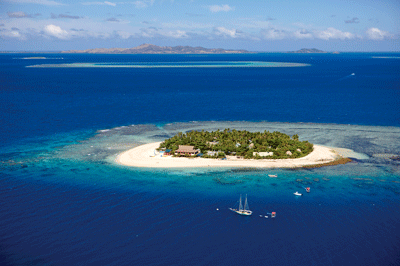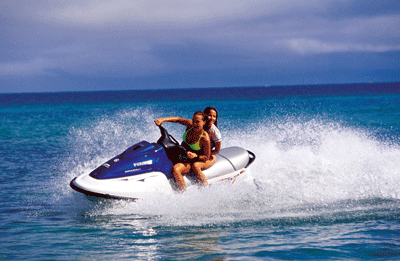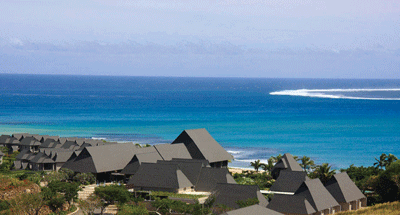Southeast Asia has no shortage of five-star resorts in tropical settings, and destinations such as Koh Samui and Bali have reigned supreme in the last decade as vacationers’ favourites. So it takes something really special to get Asian travellers out of their home region. The Maldives has successfully attracted many with a sublime natural environment and ultra-exclusive resorts. Mauritius is also gaining attention by marketing its geography and new facilities. Now Fiji, an island nation in the South Pacific 2,000km northeast of New Zealand’s North Island, is also making an effort to attract the increasingly affluent Asian traveller.
But unlike many of its counterparts, Fiji is not a new destination, at least not to travellers from the southern hemisphere. For many years, this archipelago of more than 332 islands and more than 500 islets relied mostly on arrivals from its Australasian neighbours to support its tourism. Of the 631,868 visitors recorded last year, 318,185 were from Australia and 97,857 from New Zealand. Incoming Asian travellers were mostly from Japan.
But things are changing as the national airline Air Pacific ceased its service to Japan and opened the Hong Kong-Nadi route in hopes of tapping the lucrative China market. There are now three flights weekly. But does the country have what it takes to rival tropical paradises in Asia and get people to travel across the equator for it? I made a visit and stayed at two of the most established resorts in the country.

Set sail for paradise
The nine-hour flight felt a little long, especially on a rather dated B767-300ER with limited inflight entertainment. But then, it was probably a change of pace for a Hong Kong urbanite like me who had never learned how to slow down. I did the old-fashioned thing, struck up a conversation with my neighbour and, after the meal, dozed off.
Once at Nadi International Airport – a simple but efficient facility – I could finally believe that I was heading for paradise. The weather was warm, the air fresh and the atmosphere was relaxed.
The airport is located on Viti Levu, one of the country’s two major islands. Together with the second largest island Vanua Levu, it accounts for 87 percent of the population of almost 850,000. The capital of Suva is three hours’ drive east from Nadi International Airport on the west coast, but most visitors don’t set foot there. Instead, they stay on the east side for the many resorts and leisure facilities.

As a tourist you are unlikely to spend much time in Nadi, although it is a good stop for stocking up on necessities and provisions that will cost much more to buy at the resort. There is an arts and crafts market, but the merchandise is not spectacular.
Like most visitors I only made a quick stop in Nadi before heading to Port Denarau to catch the ferry by South Sea Cruises (www.ssc.com.fj) for the Mamanuca Group of islands, home to many famous resorts. Lying 30km west of Nadi, this cluster of islets ranges from low coral cays to those of volcanic origin.
Departing three times a day, the comfortable catamaran has both an air-conditioned interior and an open-air deck. It makes many stops, including one for Castaway Island. Judging from the stream of guests that disembarked, the resort was still very popular 40 years on. On the boat there were families, but more of the passengers were young couples on holiday, with a few golden-brown tanned surfers in the mix. There was a nice buzz throughout the journey, and for a while, it felt like spring break all over again.
Far and away
My stop was the Mana Island Resort, a property spread over about 1.2sqkm on a volcanic island, with six categories of bures (Fijian for “hut”), a chapel, restaurant and a private airstrip. People can also come here from Nadi airport directly on a 20-minute flight. The charm of this property lies more in its rusticity than its luxury. The bures have gone through renovation recently, but the original flavour has been kept. The island bures are all, as they should be, built with wood, and inside tiles with pictures depicting local folklore line the fringes of the ceiling for an extra touch of authenticity.
Mana is very green and wreathed with picture-perfect white beaches and crystal-clear waters. You can walk everywhere, although motorised carts are also available to shuttle you around. The rolling, soft grass hills inland make for some decent hiking. The island is big enough for a good walk but not so much that you’ll get lost. But if you still prefer to play it safe, guided bush walks are on offer.
I went to the water activity centre to sign up for snorkelling. It took rather a long time for the staff to get everything ready – this is Fiji and no one rushes – but finally a group of guests, along with two instructors, set off to a sand island about half an hour away by speedboat. After some snorkelling, we swam back to the deserted island as the staff proceeded to prepare a simple picnic with tea and coffee, and digestive biscuits. But it was really the serene environment that we were feeding on, and as we sat together sipping tea amidst the sea breeze, it felt as if time had stood still and all worries in the world were washed away.
At night, guests gathered at the modestly furnished lounge for drinks, with some preferring corner tables for a quiet tête-à-tête while others took the stage for some karaoke action. Not every singer hit the right notes, but they all got some applause because, after all, it was just for fun.
The following day, before taking off to another resort, I had a relaxing lunch at South Beach Restaurant, on the outdoor deck with a view out over the water. It took a good 20 minutes for my bottle of beer to arrive – again, I had to remind myself that I was on a slow-paced island – but when I finally took a sip of it I was ready to forgive. The surroundings were so peaceful and nothing could bother me for long. The grilled lobster was simple, but it was exactly what I needed.
The lagoon
After the ferry back to Port Denarau, I took a southbound ride for 8km and arrived at the jetty for Sonaisali Island Resort, which technically is a peninsula that forms a lagoon with the mainland. To get there, you need to take the shuttle ferry to cross the narrow body of water, a ride that adds a sense of exclusivity to this property.
Unlike Mana, this resort doesn’t rely on the beach as its attraction. In fact, the water around this location is a little muddy. Instead, most guests hang out at the lagoon-style pool, surrounded by lush greenery. Overlooking the pool is open-air Sunset Terrace Restaurant, where between meal times many guests come to socialise over drinks and snacks.
A mini-mall features shops for both necessities and souvenirs, as well as a hair salon. Some of the merchandise was actually rather stylish, including a dark-green and red floral shirt that I bought in preparation for my sunset cruise.
At around 5pm I arrived at the beach on the north side of the resort to board the Cagi Malua 35ft luxury catamaran. The sky wasn’t very clear on that particular day, but it didn’t dampen the passengers’ mood as they sipped champagne, ate canapés and soaked in the Fijian music. Tipsy, I lay down on the net in the middle of the outdoor deck, and listened to the waves and sounds of water rushing by under me.
After the cruise, I was invited to join a group of diners to try some kava, a slightly hallucinogenic drink made from the root of an indigenous plant and served from a wood bowl, before diving into a meal of international dishes at The Plantation Restaurant.
After dinner, I managed to find my way back to my oceanview bure, which was no easy feat after all the kava – and the paths weren’t very well lit either. The lighting of my room was also not very good, and the bathroom was actually lit by a fluorescent tube! (I am happy to hear that the hotel has recently gone through a renovation and this issue has been corrected.) But what these beachfront bures are loved for is the location. At night, you get to fall asleep to the sound of the ocean waves, and the cool breezes that slip through the wood-frame windows are wonderfully soothing. I also found it delightful to walk out to the verandah for fresh air in the morning.
If the host of dive trips, jet-skiing and paintball games don’t tempt you, maybe three hours of pure pampering will. To me, the best way to spend the day here would be “Taste of Heaven”, a package offered by the Frangipani Health and Beauty Spa consisting of a ritual hot stone therapy, express facial, and coconut sugar renewal treatment. The price tag of F$612.8 (US$344.4) is a little hefty, but then, what is a holiday if you don’t splurge a little?
Neither of the resorts that I stayed at was over the top in luxurious trimmings, yet they both had their own unique charm that was irresistible. I could not quite pinpoint what it was, but at the airport waiting for my flight home, I was already missing Fiji. Then came a moment of clarity, and I realised that for all the rush by new resorts around the world to push the levels of decadence and luxury to exotic heights… sometimes things are best kept simple.
Going international
Most of the established resorts in Fiji are independently owned and operated, but many global hotel names are entering the market. Here are a few examples:

InterContinental Fiji Golf Resort and Spa (pictured) is one of the country’s newest luxury resorts, located on the stunning Natadola Beach on Viti Levu. All the bures are surrounded by landscaped gardens and equipped with modern amenities such as flat-screen TVs. There are five food and beverage outlets, a world-class spa, four swimming pools, an 18-hole championship golf course, kid’s club, wedding pavilion and conference facilities. You can wine and dine while taking in the breathtaking natural sceneries, or head to uber-chic Kama Lounge and chill out with a cocktail under the starry sky. Evening cultural shows are showcased on the Meke lawn. There are also guided tours to the nearby Sanasana Village, which takes two hours and costs F$15 (US$8.5) per person.
www.ichotelsgroup.com/intercontinental/en/gb/locations/fiji
Shangri-La’s Fijian Resort and Spa was the first international brand to land in Fiji some three decades ago, this property occupies the private Yanuca Island and is well designed for family vacations, with facilities including children’s play areas and a wide range of dining and recreation options such as golf, PADI courses and a CHI spa. All 442 guest rooms and suites feature contemporary but Fijian-inspired decors, private balconies and views of the South Pacific.
www.shangri-la.com/en/property/yanucaisland/fijianresort
Sofitel Fiji Resort and Spa, at a private waterfront location, infuses French influences with exotic Fijian customs and tops off the experience with modern technologies. It boasts the Pacific’s largest lagoon-style pool and every room has a private balcony or terrace. There are indoor and outdoor dining options, including V Restaurant serving up decadent dishes such as Nadi bay prawns flamed with French brandy, garlic and chive butter; and slow braised Yaqara beef cheeks, truffled potato and fried shallot with whole grain mustard and cabernet dressing. Of course there is also a spa, event and conference facilities and a beachfront chapel for those coming here to tie the knot.
Locally owned and operated but certainly of international standards is Likuliku (meaning “calm waters”), which is celebrating its fourth year. Part of the Mamanuca archipelago, this resort is the first and only resort in Fiji with over-water bures. Structures have been designed and built to complement the natural environment and with efforts to minimize the need to cut down trees. The man-made Masima Island & Bar, which is also the reception area connected to the main resort area by a wood bridge, is a great place for star-gazing at night. There are many water activities, bush walks and village visits to keep you occupied, and another great thing about staying here is that main meals are included in the room rate, which at press time starts from F$1,594 (US$888.5) for a Garden Beachfront Bure.
How to get there
National airline Air Pacific (www.airpacific.com) flies between Hong Kong and Nadi three times a week, and also serves Australia, New Zealand, Los Angeles, Vancouver (via Honolulu) and Honolulu. Other carriers that fly to Fiji include Air New Zealand (www.airnewzealand.com) and Korean Air (www.koreanair.com).
Details
Castaway Island
Tel +679 666 1233
Mana Island Resort & Spa
Tel +679 6661455
Sonaisali Island Resort
Tel +679 670 6011








